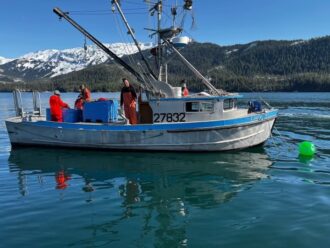Alaska is relatively new to the business of farming kelp, a type of seaweed gaining popularity across the globe because it’s healthy for humans and good for the planet, too. Kelp is rich in vitamins, minerals and protein, requires no soil or fertilizers to grow, provides habitat for fish, and balances ocean acidification caused by climate change. Cultivating sea greens can also support local economies and food security, which is especially important in remote, coastal communities that rely heavily on the harvest of dwindling wild species like salmon.
In many ways, kelp farming is a natural fit for the cold waters of Alaska. But farmers there are grappling with how to engineer their systems to keep profits afloat.
“What works for kelp farmers in the Northeast doesn’t always translate to conditions here,” explained Skye Steritz, co-owner of Noble Ocean kelp farm in Cordova, Alaska. “Farmers in our region have tried the conventional, single-line approach and it leads to tangled lines, equipment failure and low-crop density. Most small farmers are struggling to achieve profitability.”
Steritz and her team recently received a $25,000 SARE grant to test a novel farming system they hope will maximize the amount of kelp grown in the least amount of ocean space. Experiments are scheduled to begin this fall.
Gardening underwater
In theory, setting up a kelp farm is fairly simple. Kelp grows naturally in the sea, and it can also be grown from spore found in adult seaweed. In Alaska, farmers collect seed from the healthiest stock they find within 15 kilometers of their farm, drawing material from at least 50 “plants” to protect genetic diversity. They pack the fertile material in insulated coolers and hurry them off to nurseries where they are seeded on strings and nurtured underwater for six weeks.
Farmers then seed those strings onto larger ropes and submerge them with anchors and buoys to keep the lines tensioned and intact throughout the cold, windy growing season. That’s where things can get tricky. Kelp matures during winter when the winds are high and the seas are rough, which can damage the farm’s system of lines and bouys.
“We struggle with maintaining adequate tension during large tidal fluxes and weather events,” Steritz noted.
The team’s technical advisor, Clifford Goudey, has engineered a multi-line system that provides powerful tension using five ropes lined side-by-side. This fall, the team will set up the new system alongside a conventional single-line array. They will measure and compare performance metrics such as kelp growth, cost and ocean space used.
“Nutrient-rich kelp is so valuable to marine biodiversity and food security,” Steritz said. “We look forward to sharing what we learn with our community to support both human health and ocean healing.”
